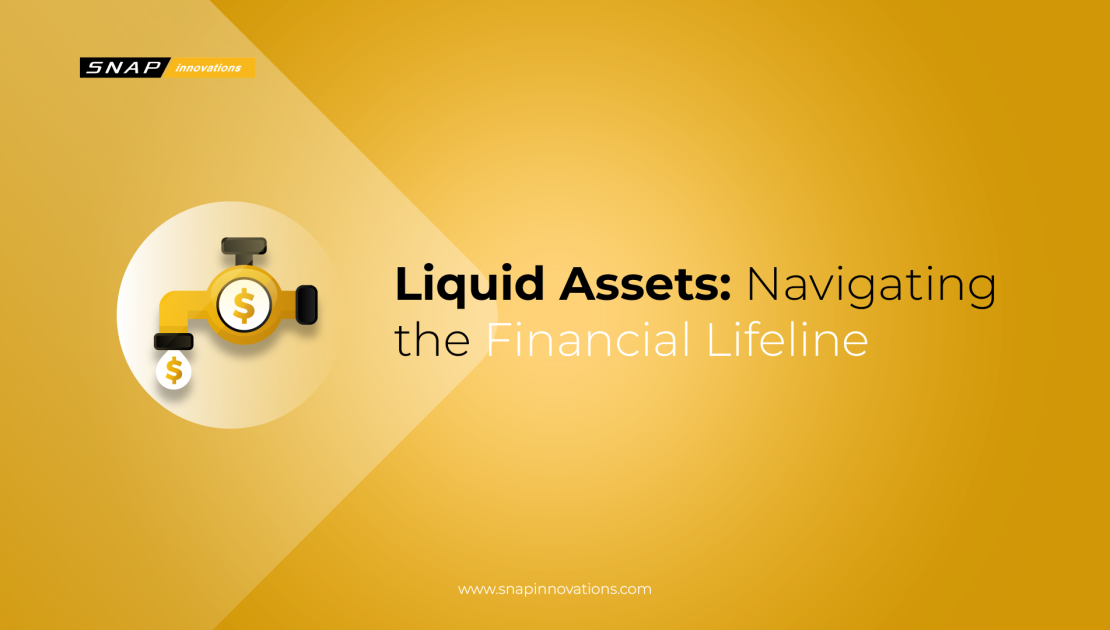In the intricate web of personal finance and economic planning, the term “liquid assets” holds a prominent place. These assets are akin to the financial lifelines that provide a safety net when unforeseen circumstances strike or when opportunities for financial growth arise.
Whether you’re on the path to financial stability or navigating the peaks and valleys of economic landscapes, understanding liquid assets is essential. In this comprehensive guide, we’ll delve into the world of liquid assets, unraveling their significance, types, benefits, and how they can be your financial savior.
What Are Liquid Assets?
Liquid assets, often regarded as the financial backbone of personal and business finances, are the monetary resources that can be effortlessly converted into cash without incurring substantial losses in their value. These assets serve as the financial lifelines that can be swiftly deployed to navigate unexpected financial storms or seize opportunities for growth. They encompass the readily available portion of one’s wealth, representing a cache of financial flexibility.
Liquid assets encompass a diverse array, ranging from tangible cash in hand and bank account balances to assets like stocks and bonds that can be swiftly liquidated in open markets. In essence, they are the currency of financial agility, standing as the first responders in the face of unforeseen expenses, facilitating quick access to funds when needed most, and serving as the bedrock of financial planning and security. Understanding the nature, types, and importance of liquid assets is crucial in mastering the art of financial management and securing one’s financial well-being.
Furthermore, money market accounts and certificates of deposit (CDs) are considered liquid assets. Money market accounts offer higher interest rates compared to regular savings accounts while providing easy access to funds. CDs, on the other hand, offer higher interest rates in exchange for locking funds for a specific period, making them relatively less liquid until they reach maturity.
Types of Liquid Assets
Before delving into the various types of liquid assets, it’s crucial to understand what liquid assets are in the context of financial management. Liquid assets are financial resources that can be quickly converted into cash or used to meet immediate financial obligations
1. Cash on Hand
Cash on hand, the most immediate form of liquid asset, includes physical currency such as bills and coins. This tangible asset is readily accessible for everyday expenses and emergencies. Having cash on hand is essential for covering immediate financial needs, such as groceries, transportation, or small unplanned expenses.
While it may not generate any returns, its high liquidity makes it a valuable component of financial planning. Individuals and businesses alike prioritize maintaining a certain level of cash on hand to ensure they can swiftly address unexpected financial obligations, seizing opportunities or weathering unforeseen challenges.
2. Bank Account Balances
Checking and savings accounts held at financial institutions are among the most common types of liquid assets. They provide easy access to funds, making them versatile and highly liquid. Bank account balances can be accessed through various means, including online transfers, withdrawals at ATMs, and electronic bill payments.
This liquidity is especially valuable for day-to-day financial transactions, ensuring that individuals and businesses can meet their ongoing financial needs efficiently. The ability to move funds between accounts, pay bills, and make purchases contributes to the accessibility of these liquid assets.
Also Read: Top 10 Machine Learning Algorithms For Beginners
3. Stocks
Stocks represent ownership shares in companies and are actively traded on stock exchanges worldwide. While stock values can fluctuate based on market conditions, they offer a considerable degree of liquidity. Investors can readily sell stocks to access cash, either through brokerage accounts or stock exchanges.
The ease of buying and selling stocks makes them a popular choice for those seeking both investment potential and liquidity. However, it’s crucial to note that market volatility can impact the selling price of stocks, so timing can be a factor when converting them into cash.
4. Bonds
Bonds are debt securities issued by governments or corporations. They provide regular interest payments, often on a semi-annual basis, and can be traded on bond markets. Bonds offer varying degrees of liquidity, depending on factors such as the type of bond and its maturity date.
Government bonds, for example, are often highly liquid due to their lower default risk, while corporate bonds may be less liquid. Bonds with specific maturity dates may become more liquid as they approach maturity. Investors looking for a balance between income generation and liquidity may consider a diversified bond portfolio.
5. Money Market Accounts
Money market accounts (MMAs) combine features of savings and checking accounts. They offer higher interest rates than regular savings accounts while providing liquidity through check-writing and debit card access. MMAs are typically offered by financial institutions and are subject to regulatory guidelines designed to ensure their stability and liquidity.
These accounts are considered a relatively low-risk option for individuals looking to earn higher interest rates than traditional savings accounts while maintaining accessibility to their funds. MMAs can serve as a valuable component of an emergency fund or short-term savings strategy.
6. Certificates of Deposit (CDs
Certificates of deposit (CDs) are time deposits offered by banks and credit unions. They provide higher interest rates than regular savings accounts in exchange for locking in funds for a specified period, known as the CD’s maturity. While CDs offer attractive interest rates, their liquidity is lower compared to other liquid assets.
Early withdrawal from a CD is possible but typically results in penalties, which can reduce the overall return. CDs are suitable for individuals who can commit funds for a specific term and are less concerned with immediate liquidity needs.
7. Real Estate Holdings
Real estate assets include residential and commercial properties, land, and other real property investments. While real estate holdings are valuable, their liquidity varies depending on several factors. Residential properties are generally more liquid than commercial ones due to higher demand in the housing market.
Liquidity in real estate also depends on location; properties in urban areas tend to be more liquid than those in rural regions. When selling real estate, market conditions play a significant role in determining the time it takes to find a buyer and obtain fair market value. For many individuals, real estate holdings serve as long-term investments rather than readily accessible liquid assets.
8. Valuable Possessions
Valuable possessions encompass items such as art, jewelry, collectibles, and antiques. While these possessions can hold significant value, their liquidity can be considerably lower than other types of assets. Realizing the value of these possessions often requires time and effort to identify potential buyers, negotiate prices, and complete transactions.
Additionally, the liquidity of valuable possessions may depend on factors like market demand, rarity, and condition. While these items can be sold to convert them into cash, individuals should be prepared for potentially lengthy sales processes when dealing with valuable possessions.
Understanding the various types of liquid assets helps individuals and businesses manage their financial resources effectively. By maintaining a balance between highly liquid assets for immediate needs and less liquid assets for long-term goals, individuals can ensure they have access to funds when needed while optimizing their overall financial strategy.
The Benefits of Liquid Assets
 Liquid assets offer a multitude of advantages in the realm of personal finance. Firstly, they provide a safety net for unexpected financial emergencies, ensuring that you have readily available funds to cover urgent expenses like medical bills, car repairs, or home repairs, without resorting to high-interest loans or credit card debt. Moreover, liquid assets offer flexibility in your financial decisions, allowing you to seize investment opportunities or take advantage of sudden market shifts. They serve as a source of peace of mind, relieving the stress associated with unforeseen circumstances or fluctuations in income.
Liquid assets offer a multitude of advantages in the realm of personal finance. Firstly, they provide a safety net for unexpected financial emergencies, ensuring that you have readily available funds to cover urgent expenses like medical bills, car repairs, or home repairs, without resorting to high-interest loans or credit card debt. Moreover, liquid assets offer flexibility in your financial decisions, allowing you to seize investment opportunities or take advantage of sudden market shifts. They serve as a source of peace of mind, relieving the stress associated with unforeseen circumstances or fluctuations in income.
Furthermore, liquid assets contribute to financial liquidity, a key component of effective money management. They enable you to meet daily living expenses, manage cash flow, and navigate life’s uncertainties with confidence. Whether it’s covering monthly bills, funding your child’s education, or embarking on a dream vacation, liquid assets are the financial lifeline that ensures you have the means to achieve your aspirations without disrupting your overall financial health.
Another benefit of liquid assets is their role in building an emergency fund, an essential financial cushion that safeguards against unexpected setbacks. An adequately funded emergency fund, primarily consisting of liquid assets, can help you weather periods of unemployment, health crises, or unforeseen financial burdens, reducing the need to rely on high-interest borrowing options. Moreover, liquid assets are instrumental in seizing investment opportunities when market conditions are favorable, capitalizing on dips in asset prices, or participating in initial public offerings (IPOs).
The Importance of Liquid Assets in Financial Planning
 In the realm of financial planning, liquid assets play a pivotal role in securing one’s economic stability and providing a buffer against unforeseen circumstances. These assets, often referred to as the lifeblood of financial well-being, possess the unique ability to be readily converted into cash when needed, making them an essential component of any robust financial strategy.
In the realm of financial planning, liquid assets play a pivotal role in securing one’s economic stability and providing a buffer against unforeseen circumstances. These assets, often referred to as the lifeblood of financial well-being, possess the unique ability to be readily converted into cash when needed, making them an essential component of any robust financial strategy.
1. Emergency Preparedness
Liquid assets provide individuals with the means to assist others in times of need. Whether helping a friend or family member facing a financial challenge or contributing to a charitable cause, having accessible funds allows for acts of generosity and support. Liquid assets not only safeguard your financial well-being but also enable you to make a positive impact on the lives of others.
This ability to offer a helping hand fosters a sense of community and strengthens social bonds, creating a ripple effect of kindness and solidarity that extends far beyond personal finances.
2. Capitalizing on Opportunities
Liquid assets empower individuals to take calculated risks in pursuit of financial growth. Whether it’s investing in education, starting a new business, or venturing into a new market, having readily available funds provides the freedom to explore and innovate.
The ability to seize opportunities not only benefits personal financial growth but can also contribute to economic development and innovation on a broader scale. By fostering an environment of entrepreneurship and innovation, liquid assets drive economic progress and shape the future of industries and markets.
3. Day-to-Day Financial Transactions
Liquid assets facilitate more than just basic financial transactions. They empower individuals to make informed decisions about their spending and saving habits. By tracking daily expenses and managing liquid assets effectively, individuals can develop better financial discipline and a deeper understanding of their financial priorities.
This, in turn, can lead to improved budgeting and financial planning skills. The cultivation of responsible financial habits not only benefits individuals but also strengthens financial literacy on a societal level, promoting economic stability and resilience.
4. Debt Management
Effective debt management involves more than just paying off existing debts. It also entails avoiding high-interest debt in the first place. Liquid assets provide a buffer against unexpected expenses, reducing the need to rely on credit cards or loans when financial emergencies arise.
This preventive aspect of debt management helps individuals maintain a healthier financial outlook and avoid the cycle of accumulating debt. By reducing the reliance on credit, liquid assets contribute to broader financial stability and a reduced risk of financial crises at the societal level.
5. Investment Diversification
Liquid assets contribute to better risk management within investment portfolios. They allow investors to reallocate funds strategically during market fluctuations or when new opportunities emerge. This adaptability ensures that investments remain aligned with long-term financial goals and risk tolerance.
Furthermore, liquid assets provide a cushion during market downturns, reducing the pressure to sell investments at unfavorable prices. By promoting diversified investment strategies, liquid assets foster greater stability in financial markets and reduce systemic risks.
6. Retirement Planning
While retirement accounts are vital, liquid assets offer retirees flexibility in how they manage their finances during retirement. They can be used to cover unexpected healthcare costs, fulfill lifelong dreams, or provide financial support to loved ones.
The ability to draw from liquid assets without penalties or restrictions enhances retirees’ financial independence and quality of life. This financial flexibility allows retirees to enjoy a more fulfilling retirement, contributing to their overall well-being and happiness.
7. Income Replacement
Liquid assets are a reliable source of income replacement during unforeseen disruptions. Whether facing a temporary disability or the need to care for a family member, having accessible funds can bridge gaps in income and maintain financial stability.
This added security extends to other aspects of life, such as pursuing further education or transitioning to a new career. By offering a safety net during challenging times, liquid assets empower individuals to navigate life’s unexpected twists and turns with resilience and confidence.
8. Peace of Mind
The peace of mind provided by liquid assets goes beyond financial security. It contributes to emotional well-being and overall life satisfaction. Knowing that you have the resources to handle life’s uncertainties allows you to focus on personal growth, relationships, and enjoying life’s experiences.
Peace of mind fosters a positive attitude toward financial planning and encourages individuals to set and achieve their financial goals with confidence. This sense of financial security extends to the broader population, fostering a culture of financial responsibility and well-being that benefits society as a whole.
Strategies for Managing Liquid Assets
 Effectively managing liquid assets involves a combination of prudent financial practices and a clear understanding of your financial goals. Begin by establishing a budget that outlines your income, expenses, and savings objectives. Prioritize building an emergency fund, typically covering three to six months’ worth of living expenses, to safeguard against unexpected financial challenges. Consider automating your savings by setting up regular transfers to designated savings accounts, ensuring that you consistently allocate a portion of your income to liquid assets.
Effectively managing liquid assets involves a combination of prudent financial practices and a clear understanding of your financial goals. Begin by establishing a budget that outlines your income, expenses, and savings objectives. Prioritize building an emergency fund, typically covering three to six months’ worth of living expenses, to safeguard against unexpected financial challenges. Consider automating your savings by setting up regular transfers to designated savings accounts, ensuring that you consistently allocate a portion of your income to liquid assets.
Also Read: Hyperparameters: Optimizing Machine Learning Models
Diversify your liquid assets across different types of accounts, such as checking, savings, money market, and certificates of deposit, to optimize returns and liquidity. Regularly review and update your financial goals, adjusting your liquid asset management strategies as your financial situation evolves. Additionally, seek guidance from financial professionals or advisors to create a customized plan that aligns with your specific financial objectives and risk tolerance. By implementing these strategies, you can harness the power of liquid assets to secure your financial future and achieve your financial aspirations.
Additionally, explore high-yield savings accounts or money market funds to maximize the interest earned on your liquid assets without sacrificing accessibility. Keep an eye on interest rates offered by various financial institutions and be open to transferring funds to accounts with better rates to optimize your returns. As your financial situation evolves, periodically reassess your risk tolerance and adjust your investment and liquid asset allocation accordingly.
Conclusion
In conclusion, liquid assets are the financial lifeline that keeps your financial ship afloat in turbulent waters and provides you with the agility to seize opportunities when they arise. By understanding their types, benefits, and the role they play in financial planning, you can navigate your financial journey with confidence and resilience.
However, it’s equally vital to address the challenges they present and adopt effective strategies to maximize their potential while mitigating risks. In doing so, you can ensure that your liquid assets remain a valuable and versatile component of your financial well-being.


